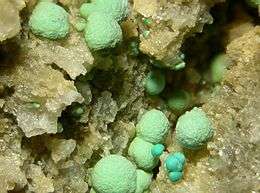Strashimirite
Strashimirite is a rare monoclinic mineral containing arsenic, copper, hydrogen, and oxygen. It has the chemical formula Cu8(AsO4)4(OH)4·5(H2O).[6][7]
| Strashimirite | |
|---|---|
 | |
| General | |
| Category | Arsenate mineral |
| Formula (repeating unit) | Cu8(AsO4)4(OH)4·5(H2O) |
| Strunz classification | 8.DC.12 (10 ed) 7/D.07-20 (8 ed) |
| Dana classification | 42.6.5.1 |
| Crystal system | Monoclinic Unknown space group |
| Space group | P2/m, P2, or Pm |
| Unit cell | a = 9.71 Å, b = 18.81 Å c = 8.94 Å; β = 97.2°; Z = 3 |
| Identification | |
| Color | White, pale green |
| Crystal habit | Elongated, tabular crystals; crusts; radiating aggregates |
| Cleavage | Parting at right angle to elongation |
| Mohs scale hardness | 2.5 - 3 |
| Luster | Greasy, pearly |
| Diaphaneity | Semitransparent |
| Specific gravity | 3.67 (calculated) |
| Optical properties | Biaxial (-) |
| Refractive index | nα = 1.726 nγ = 1.747 |
| Birefringence | δ = 0.021 |
| Pleochroism | Weak; Y = very pale yellowish green; Z = yellowish green |
| 2V angle | 70° |
| References | [1][2][3][4][5] |
This mineral was discovered in Zapachitsa (Zapacica) copper deposit, Svoge, Sofia Oblast, Bulgaria in 1960, by the Bulgarian mineralogist Jordanka Minceva-Stefanova.[8] She named the mineral after Strashimir Dimitrov (1892-1960), Professor in Mineralogy and Petrography at Sofia University "St Kliment Ohridski", Bulgaria.[9] The International Mineralogical Association approved it as a new mineral in 1968.[10]
It occurs as a secondary mineral phase in the oxidation zone of copper arsenide deposits. It occurs associated with tyrolite, cornwallite, clinoclase, euchroite, olivenite, parnauite, goudeyite, arthurite, metazeunerite, chalcophyllite, cyanotrichite, scorodite, pharmacosiderite, brochantite, azurite, malachite and chrysocolla.[1]
Although it remains quite rare, strashimirite has subsequently been identified in a number of locations including: Novoveska Huta in the Czech Republic; on the west flank of Cherbadung (Pizzo Cervandone), Binntal, Valais, Switzerland; in Kamsdorf and Saalfeld, Thuringia, Germany; the Clara mine, near Oberwolfach, Black Forest, Germany; in the Richelsdorf Mountains, Hesse, Germany; Cap Garonne mine, near le Pradet, Var, and Triembach-au-Val, Haut-Rhin, France; Wheals Gorland and Unity, Gwennap, Cornwall, England; the Tynagh mine, near Loughrea, Co. Galway, Ireland; the Majuba Hill mine, Antelope district, Pershing Co. Nevada, US; and the Centennial Eureka mine, Tintic district, Juab Co., Utah, US.[1]
See also
Notes
- Handbook of Mineralogy information page for Strashimirite
- Mindat information page for Strashimirite
- Webmineral information page for Strashimirite
- Information about Strashimirite at RRUFF Database
- Strashimirite at Mineralienatlas Lexicon
- Mincheva-Stefanova, I. (1968). "Strashimirite - a new hydrous copper arsenate (In Russian)" (PDF). Zapiski RMO (Proceedings of the Russian Mineralogical Society) (97): 4.
- Frost, Ray L.; Keeffe, Eloise C.; Cejka, Jiri; Sejkora, Jiri (2009). "Vibrational spectroscopic study of the arsenate mineral strashimirite Cu8(AsO4)4(OH)4.5H2O - relationship to other basic copper arsenates" (PDF). Vibrational Spectroscopy. 50 (2): 289–297.
- Jordanka Minceva-Stefanova (Йорданка Минчева-Стефанова)(1923-2007)
- Fleischer, Michael (1969). "New Mineral Names" (PDF). The American Mineralogist. 54: 1221.
- Stoilova, D.; Minčeva-Stefanova, J (2001). "Infrared Spectroscopic Study of Strashimirite". Comptes Rendus de l'Académie Bulgare des Sciences. 54 (8): 49–52.
| Wikimedia Commons has media related to Strashimirite. |